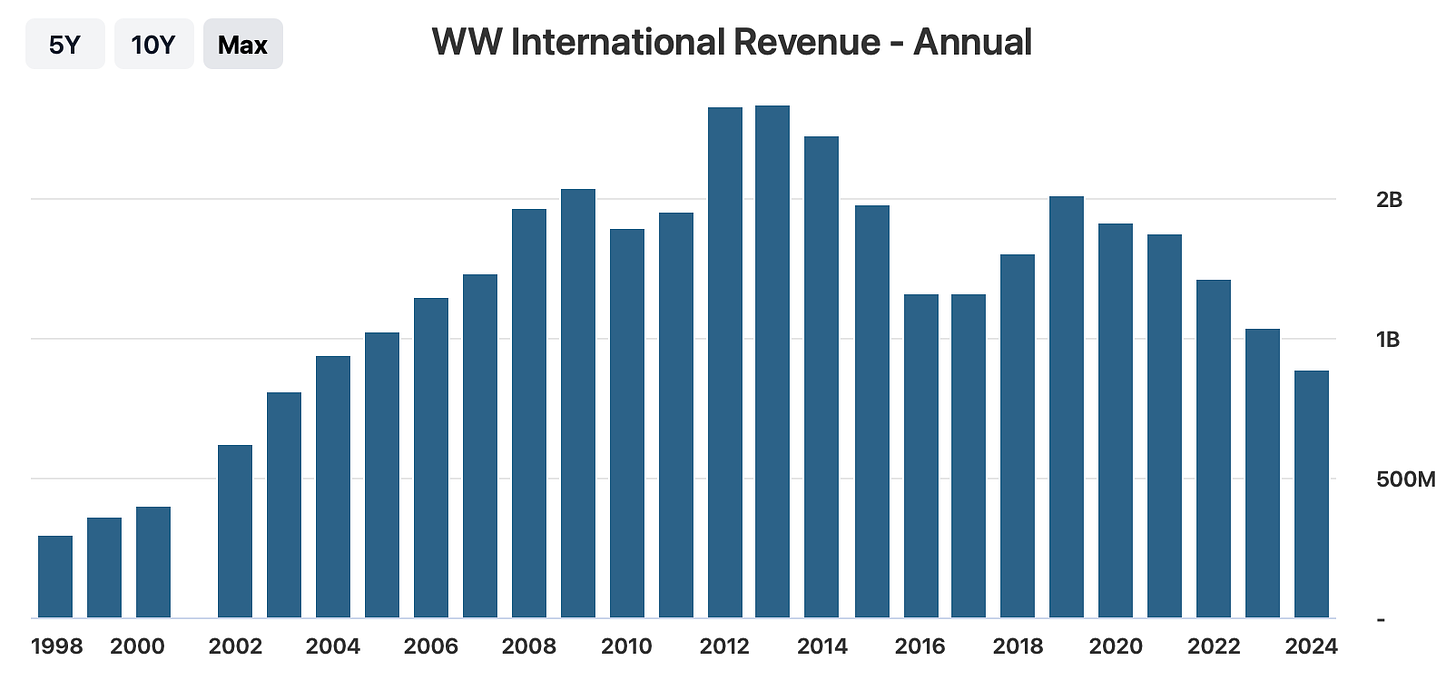The Drugs Have Won and the Smart Money Knows It (credit to Jake Novak for this great line)
Mar 11, 2024What do you do when your most visible and notable spokesperson basically declares that what you’re doing is ineffective? We’re about to find out how WW (formerly Weight Watchers) navigates.
The rise of Weight Watchers and America’s diet culture

Weight Watchers was founded by a nurse, Jean Nidtech, who had tried every kind of diet known, unsuccessfully. She eventually attended a 10-week long program offered for free by the New York City Board of Health’s obesity clinic. The prescribed diet was called “The Prudent Diet” and it worked! Jean lost 20 pounds. Like many who enjoy an initial weight loss, though, she found her commitment waning once the program, and the camaraderie that she had with fellow participants ended. So she began to coordinate weekly meetings with a support group of her own, planting the seed for the company that would become Weight Watchers.
She launched Weight Watchers as an official organization in 1963, initially leading each group session herself, but eventually building out a franchise model, in which former attendees could create their own branches and lead their own meetings. The initial idea led to a subscription-based business model which the company has maintained to this day. Over the years, Weight Watchers spokespeople have included actor Lynn Redgrave (who reportedly successfully lost 35 pounds!), Sarah Ferguson, the Duchess of York, and of course Oprah Winfrey, who bought a stake in the company and joined its board.
Weight Watchers is regarded by many as one of the more effective programs to drive lasting weight reduction, but it is no joke. There are scales to weigh food, a point system that lets you eat pizza, but then nothing else for the rest of the day. There are meals and exercise numbers to be tracked. And of course, regular meetings which are now supplemented digitally. It’s a hugely competitive market, with hundreds of weight loss programs competing for the estimated $3.9 billion in revenue people are prepared to spend on such programs – and that’s just in the United States alone.
Me, myself and Weight Watchers
Shortly after our daughter was born, and anxious about getting my now-post-2-children body back into some kind of form, I sampled a Weight Watchers meeting. It would have been in mid-October. The first thing was the weigh-in. To a newcomer, that felt strange. Then we had a short pep talk from the group organizers, who seemed very committed to the success of the group. Then we went around the room and everyone was asked to share strategies and ideas.
With Halloween coming up, there was a huge discussion of tactics for dealing with the presence of candy in the house. Some were going to ask their husbands to handle everything and to take all the leftover candy to a charity. Others were going to avoid candy altogether, handing out alternatives such as small toys. Still others were going to provide candy, but only a kind that they didn’t personally like, to minimize temptation. I’m listening to all this and thinking “this can’t possibly be the enormous challenge that these folks seem to be experiencing…”
It got even more intense when talk turned to the looming disaster that most of the group seemed to feel Thanksgiving represented. There was incredible expertise about the nutritional value, calories, fat and portion sizes of everything you might find on a Thanksgiving table. People talked about how they personally would double up on steamed broccoli in lieu of sweet potatoes. There was a debate about the best way to make a tasty turkey without basting (to this day, I’ve never understood that one). The piece de resistance, however, was one woman who said she would limit herself to a quarter-cup of gravy because gravy has so much fat in it and to make sure she didn’t slip, would keep a measuring cup at the ready.
There was no way I could ever be obsessive enough to measure out a quarter cup of gravy at the dinner table. So, my Weight Watchers adventure was short-lived. My home-made remedy turned out to be exercise videos (Bodies in Motion or Buns of Steel, anyone?) and a modest effort to keep an eye on what I ate. But I digress.
Rebranding, going digital and more
In 1978, Heinz bought Weight Watchers for $71 million, a pretty good price at the time. It sold 80% of the company to Artal Luxembourg S.A., a private European investment firm, in June of 1999. It became a public company in 2001.
The company experimented, making it simpler for members to keep track of their consumption using a points system. It formed an unlikely partnership with Burger King to offer Weight Watchers hot meals in its restaurants (as you might have guessed, that didn’t last long). New competition entered in the form of frozen foods like “Lean Cuisine” that promised flavorful meals that could simply be microwaved. It followed consumers on to the Internet, with the 2009 introduction of the “WW” app, allowing people who couldn’t reach a counselor or attend a meeting to experience the offering. They developed a digital platform, available only to members. Oprah came on board in 2015.
In 2018, Weight Watchers made a dramatic switch – moving from a focus on losing weight to what it called a renewed purpose. In its words, “we inspire healthy habits for real life. For people, families, communities, the world—for everyone.” It offered things like custom mindfulness content that members on its app could tap into.
The company was struggling to remain relevant. In fact, the detailed timeline of the history featured on its website abruptly ends in 2019. Revenue growth had stalled and the company entered the pandemic and post-pandemic period in a position of some weakness.

Source: https://stockanalysis.com/stocks/ww/revenue/
And then, the looming existential threat of effective weight-loss drugs
In 2021 the New England Journal of Medicine published a study that would change the conversation about weight management forever. It showed that weekly semaglutide injections led to an average 14.9 percent weight loss in overweight and obese people. This result got a lot of attention because it was part of an actual controlled experiment. The researchers took nearly 2,000 patients that were not diabetic, but who did have Body Mass Indices of at least 30. This group was divided into treatment (one injection/week) and placebo groups. All of them got the lifestyle interventions characteristic of Weight Watchers programs. After 68 weeks, the placebo group had lost about 2.4% body weight, while the treatment group had lost 14.9% - a major difference in effectiveness.
Breathless amounts of publicity and hype followed almost immediately. “Are we looking at life after food?” asks a New York article. There were rumors that Kim Kardashian used such a drug to fit into Marilyn Monroe’s dress at the 2022 Met Gala. As Matthew Schneier, chief restaurant critic for New York said, “Although it’s been approved and prescribed since 2017, the buy-in of Hollywood, openly or not, took Ozempic from medicine to status symbol. The message that dramatic weight loss is now readily, effortlessly available for those who can afford it spread across text chains and friend groups along with referrals to willing prescribers. Not since Botox, and before that Viagra, has a drug brand become so well-known so quickly.”
Enter the Oprah conversion
Oprah Winfrey’s weight has been a decades-long obsession, both for her and for her fans and critics alike. Like many people struggling with maintaining a healthy weight, she admitted to internalizing the blame for being heavy on insufficient willpower and poor choices. Her views on this reportedly changed in September of 2023, when Dr. Fatima Cody Stanford, an obesity expert, said “this isn't about willpower. It’s not your fault. It's how our bodies regulate weight and each of us is different, each of us is unique, not one is superior to another. We're just different and acting on those differences and treating the differences in the heterogeneity of the population is how we're going to actually make change in this disease.”
That seemed to be the permission Winfrey needed to take the plunge. By December of 2023, she said in an interview with People "The fact that there's a medically approved prescription for managing weight and staying healthier, in my lifetime, feels like relief, like redemption, like a gift, and not something to hide behind and once again be ridiculed for. I’m absolutely done with the shaming from other people and particularly myself." In February, she resigned from the Board of WW and resolved to donate her shares.
An inflection point
Well, as Suzy Welch observes on LinkedIn, this “should scare the daylights out of every one of us who leads anything. We do not pay enough attention, any of us, me included, to existential threats. Like, say, our very famous spokesperson rendering our product meaningless overnight. But that’s what leaders are supposed to do, right? We are supposed to care about our people, yes – but also see around the corners no one else even sees coming. The first part is hard enough. The second part is brutal.” Analyst Jake Novak was even more succinct: “The drugs have won and the smart money knows it” he said on LinkedIn.
Analyst Alex Fuhrman said he hasn’t seen anything like this before, and as he puts it, “it looks like interest in traditional diet companies is down pretty significantly.”
So what might WW do next? One obvious area of opportunity is to provide a bridge between potential patients and the new drugs, incorporating lifestyle and other health-related services into their treatment. Insurers, for instance, alarmed at the high cost of the weight loss drugs, might require that patients also have a relationship with a behavioral therapy provider. With many patients reluctant to sign on to a drug regimen that requires them to take the drug forever, there may be opportunities in providing maintenance services once people get to their desired weight. WW might become the B2B darling for payers – insurance companies and health plans -- to see if the expensive drugs might be rendered less necessary if patients are provided with caring support.
Whatever the company decides to do, the landscape for helping people with their weight has fundamentally changed. Even as Big Food and Big Pharma battle it out, the cultural landscape has changed from one in which weight control is a simple matter of calories in and calories expended, to a far more complex one of understanding how our systems regulate our weight. Will Weight Watchers navigate the transition? Time will tell.

